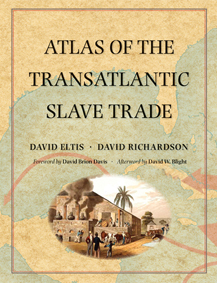Research
December 6, 2010
Atlas of transatlantic slave trade details dark history

An atlas may seem a quaint throwback in this digital age, but Emory historian David Eltis and co-author David Richardson of the University of Hull, England, have shown that a new book, "Atlas of the Transatlantic Slave Trade" can bring the 350-year history of the era alive for readers in a way that online cartography just can't match—yet.
The atlas derives from an online database (www.slavevoyages.org) that launched from Emory in 2008 to much acclaim from historians and researchers worldwide. What the atlas brings to the website and its data is much better visual resolution of the maps depicting slave trade routes.
"It's possible still, and will be for some years to come, to get much higher resolution on a hard copy [i.e. a book] than on a computer screen," says Eltis.
And the details are stunning. The 189 maps of the atlas have three dimensions: The first focuses on where slave ships began their voyages, the second on where the ships went in Africa, the third on where the ships landed in the Americas.
"What you get from this book is a sense of the direct links in the slave trade," says Eltis. "It totally overturns the idea that the vessel sets out for slaves, goes down a thousand miles of coastline, eventually gets a full cargo, then turns and crosses the Atlantic and sells essentially a group of people who perhaps can't communicate with each other."
Historians had long painted such a picture.
"We're showing that particular ports in Africa had strong connections with particular ports and therefore areas in the Americas," says Eltis. "And it's very easy to see those connections the way the data is presented in the form of maps."
Eltis calls the technique used to demonstrate those connections "pathographics," or sweeping arrows showing the movement and numbers of people from specific place to specific place.
The Gilder Lehrman Institute of American History provided funding for the book's publication in order to bring the atlas to a much wider audience, including teachers, students and the general public.
"By investing in scholars like David Eltis, this large audience will come to understand a very dark point in our nation's past," said a statement from the Institute.
"What readers will see is the extent of involvement of the whole Atlantic world in the slave trade," says Eltis. "There isn't a port of any size anywhere on the Atlantic that wasn't connected to the slave trade in some way."
Perhaps most poignantly, the atlas reflects "the moral attitudes of the time," Eltis says, adding that people engaged in the slave trade strictly on the basis of whether they could make money. "It had nothing to do with morality until the 19th century when the abolitionist movement changed the parameters somewhat."
"The fact that the slave trade wasn't part of a random process has enormous cultural significance," Eltis observes. "It means you have groups of people who were enslaved who may not have known each other, but quite possibly could speak each other's language and were the victims of the same conflict or powerful person."
As a result, he says, "it's possible to track systematic connections between Africa and the Americas in the same way that people having been doing for years between Europe and the Americas. That's probably the single most important contribution the atlas can make."
Quick Links
File Options
Related Information
- Slave trade data makes digital debut (Emory Report Nov. 24, 2008)
Search and explore the Voyages Database.
